This is a wonderful article that succinctly covers Becker’s ideas, TMT, and the state of the world:
https://newrepublic.com/article/199347/1-fear-death-wreaking-havoc-world
Ernest Becker - 1924-1974
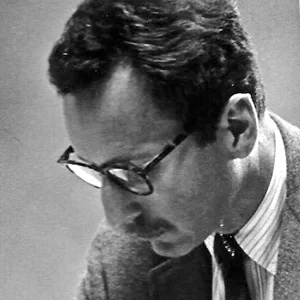
Ernest Becker - 1924-1974
This is a wonderful article that succinctly covers Becker’s ideas, TMT, and the state of the world:
https://newrepublic.com/article/199347/1-fear-death-wreaking-havoc-world
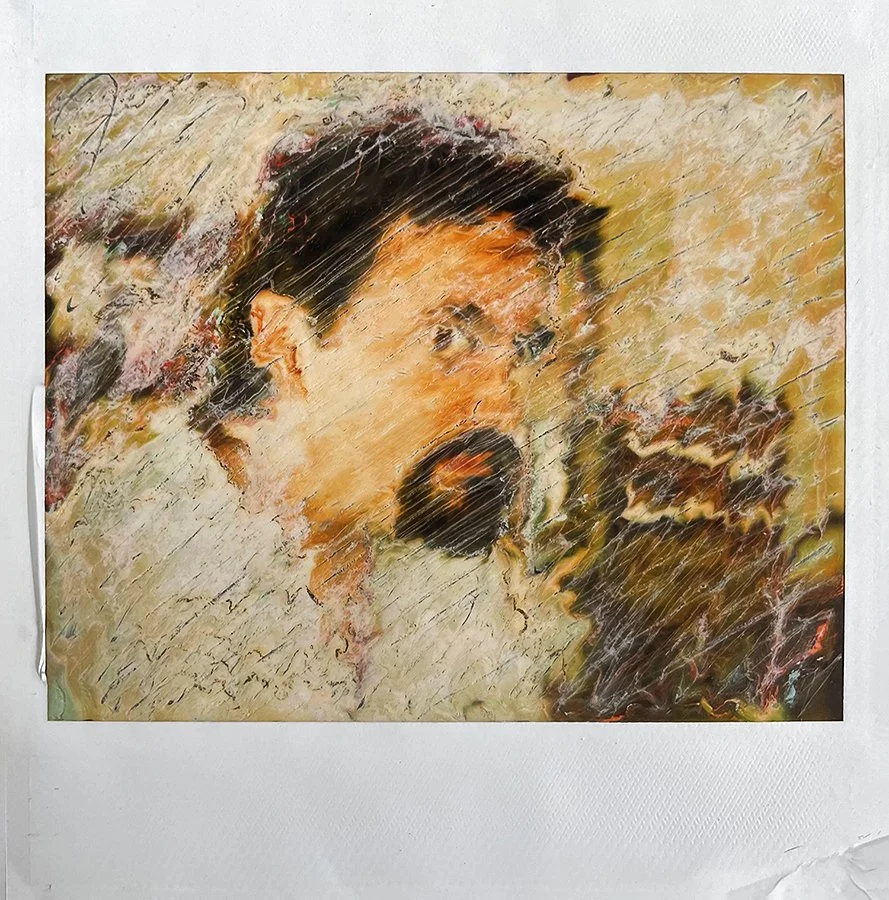
“Ode to Van Gogh,” manipulated Polaroid. 1993. Part of the Visions in Mortality exhibition.
In 1993, I put together a small exhibition called Visions in Mortality. At the time, I didn’t know Ernest Becker’s work, I hadn’t read The Worm at the Core (Terror Management Theory), and Ajit Varki and Danny Brower’s book Denial was still years away from being published. But even without the theory, I knew where my compass pointed. I wanted to make art about death anxiety and existential struggles.
Looking back now, those photographs feel like an instinctive first attempt to break through the evolutionary wall of denial. I didn’t have the language for it then, but what I was doing was confronting the thing most of us spend our lives avoiding. The work wasn’t about distraction or comfort—it was about holding mortality in front of myself and anyone willing to look.
That exhibition planted a seed. It revealed what would become the through-line of my entire practice: how do we live, create, and remain human in full awareness of our impermanence?
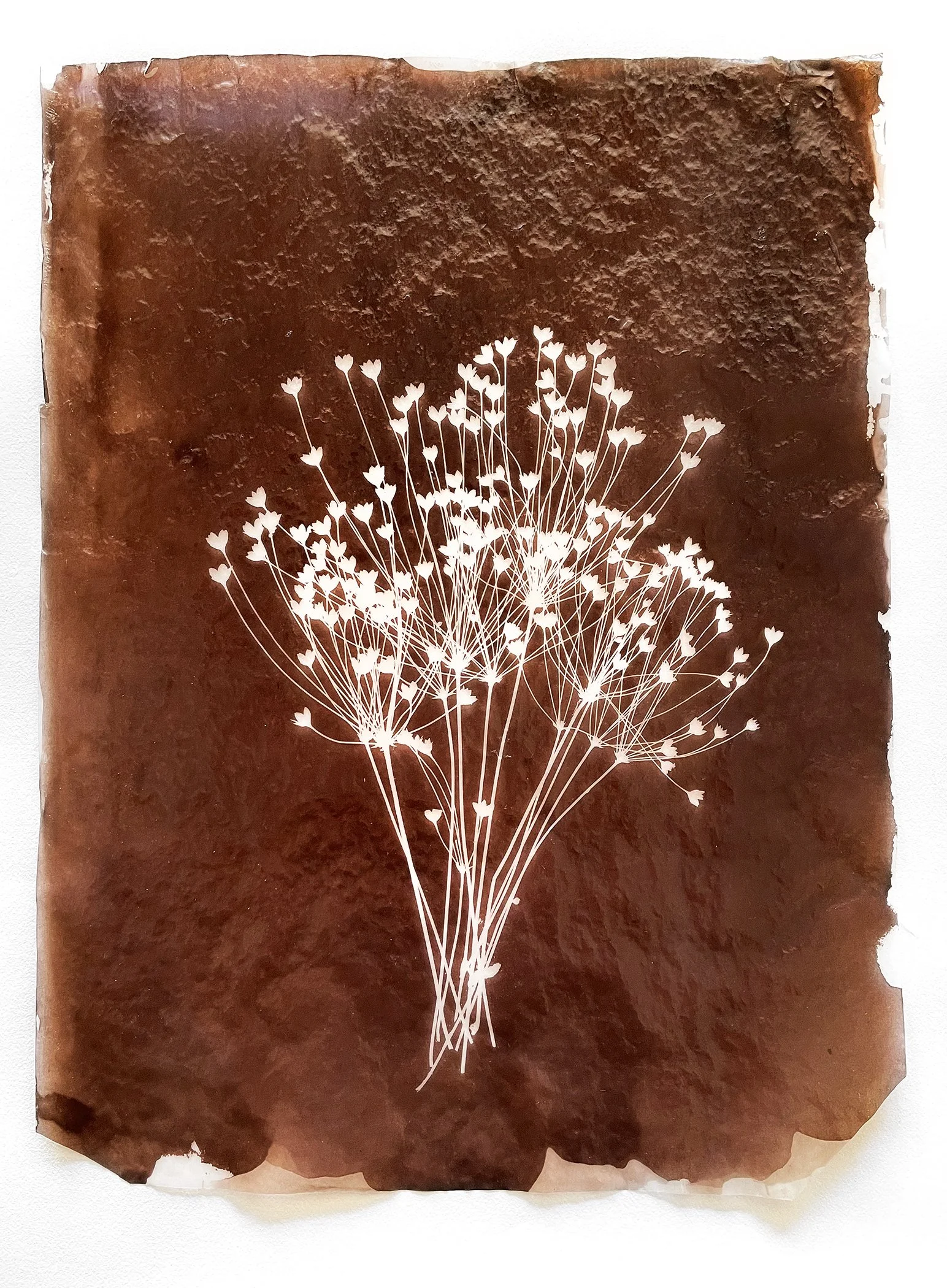
“Gone to Seed,” Whole Plate Photogenic Drawing on vellum paper (waxed). The work was created in 2022 as part of the project titled, “In the Shadow of Sun Mountain: The Psychology of Othering and the Origins of Evil.”
Three decades later, In the Shadow of Sun Mountain is the mature expression of that same impulse. Where Visions in Mortality was raw, direct, and almost primal, Sun Mountain is layered—woven through with Becker’s insights on cultural worldviews, TMT’s evidence of our defensive psychology, and Varki and Brower’s claim that denial itself had to evolve in order for us to function as conscious beings.
The difference is scope. Visions in Mortality was a solitary confrontation with death, denial, and culture. Sun Mountain is a confrontation with collective denial—the way cultures rewrite history, erase peoples, and commit violence (genocide) in the name of permanence. It’s about how our fear of death doesn’t just haunt us as individuals but shapes entire societies.
But the continuity matters more than the contrast. Both projects spring from the same recognition: that art is one of the few places where denial can falter, where we can face mortality directly without looking away. That has been my practice from the beginning, whether I had the theory to explain it or not.
Now, in my doctoral studies, I’m taking this inquiry a step further. I’m asking not only how artists confront mortality differently than others, but also what that confrontation makes possible—for art, for ethics, and for the way we live together. If Visions in Mortality was the initiation and Sun Mountain the culmination, this research is the extension. It’s an attempt to turn decades of practice into a framework that others—artists, scholars, anyone willing to face the void—can use to think differently about mortality, meaning, and art.
Visions in Mortality was the beginning. Sun Mountain is the continuation. The dissertation will be the next turn in the spiral—returning to the same question from a higher vantage: what does it mean to create, to love, to exist, knowing all along that the universe is indifferent and that everything vanishes?
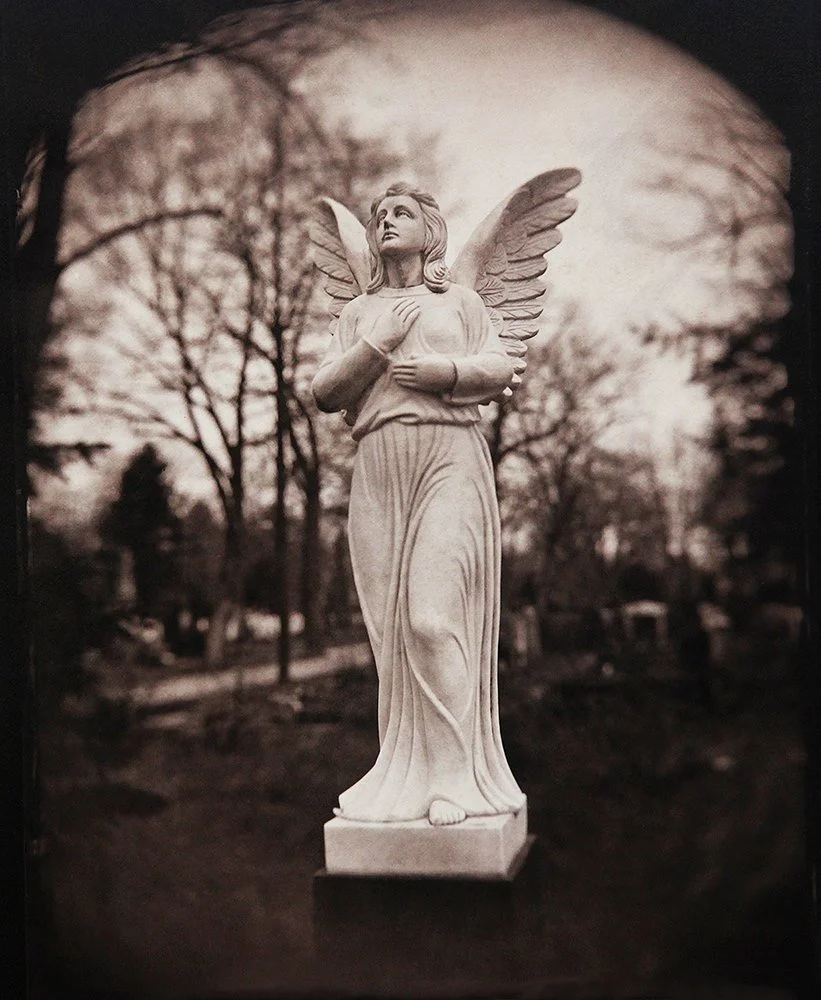
“Friedhof Käfertal” Whole plate Albumen print from a wet collodion negative. 2009
What are humans afraid of? Death, meaninglessness, loneliness (isolation), and freedom. Ernest Becker and Jean-Paul Sartre made that abundantly clear.
We prefer to act as though death is easy. Vital signs, brain scans, organ failure—we turn it over to the biologists. We say, "This is where life ends," and draw a clear line. In actuality, however, human death does not exist in the sterile realm of checklists and charts. It inhabits the world of stories and symbols.
We are frightened by more than just the body shutting down. It is the breakdown of a life dominated by others. We are held to our flimsy promises of immortality by the cutting of ties. Few people knew this better than Ernest Becker. He observed that we create our morals, our art, and our cultures as defenses against the inevitable death. We try our hardest to hide that terrible reality and to act as though our existence is more than a passing biological fad.
It is possible to declare a body on a ventilator brain-dead. It's done biologically. However, to the living, it can still be a person, a narrative, or a strand in the web we weave to keep the abyss at bay. This is painfully evident from the paper I just read: human death is always relational, moral, legal, and practical. It is more than a simple off/on switch. It marks the end of a "life-form," a life molded by ritual, language, memory, and the vows we make to one another.
There is more than just flesh left over after a death. The tangle of obligations, relationships, and rights that keeps the deceased in our world a little while longer is all that is left. Even if they only endure as long as the memory does, they continue to firmly ground us in our denial and our attempt at symbolic immortality.
The moment when our symbolic world finally breaks and we realize that all of our illusions and buffers can only last so long may be the true threshold that we fear, rather than the boundary between flatline and heartbeat.
“The idea of death, the fear of it, haunts the human animal like nothing else; it is a mainspring of human activity—activity designed largely to avoid the fatality of death, to overcome it by denying in some way that it is the final destiny for man.”
— Ernest Becker, The Denial of Death
What do you see holding your fear of death at bay? Do you lean on something? Or are you in a free-fall state of neuroticism? Afraid of both life and death?
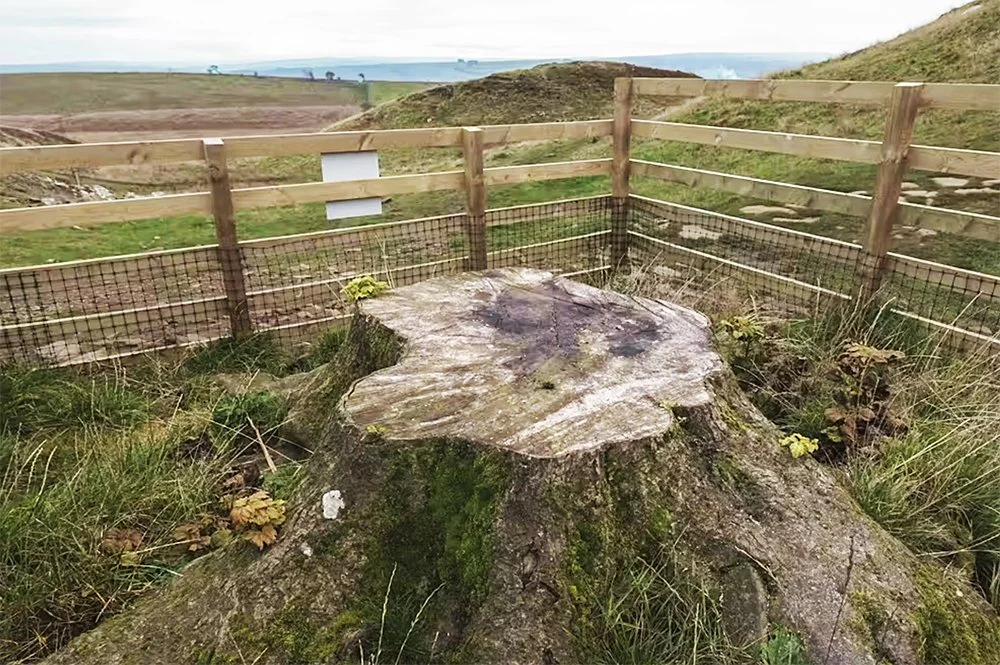
The Sycamore Gap tree was cut down in September 2023. SunCity/Shutterstock
I read an article from The Conversation yesterday about the felling of a sycamore tree in Britain. It was a tree that stood in a dip along Hadrian’s Wall. I encourage you to read it (link here).
Here are my thoughts.
When the Sycamore Gap tree was felled, people mourned it as if it were a living companion. On the surface, it was just a tree—an old, striking landmark framed by the British landscape. But for so many, it was an emotional anchor, the kind of place our minds use to orient us in the world. Psychology tells us that our brains don’t separate memory, emotion, and place as cleanly as we like to think. They’re tangled together, just like the roots of that sycamore.
Ernest Becker would have recognized the deeper undercurrent here. We’re always looking for ways to transcend our finitude—some symbolic form of permanence that outlasts us. A tree like Sycamore Gap becomes part of a cultural worldview, an immortal marker on our mental maps. When it’s destroyed, it cracks that illusion. People felt disoriented, even betrayed. It wasn’t just the loss of scenery—it was a reminder that nothing is safe from time’s reach.
In my own work, I circle this idea constantly: that our fear of death fuels our attachments, our art, our need for landmarks—literal and symbolic. We pin our anxieties onto places, trees, myths, hoping they’ll hold steady where we can’t. The Sycamore Gap tree stood alone on that ridge for centuries, and for a moment, it made us feel we could stand a little taller, too. Its absence leaves us staring straight at our own impermanence. That, perhaps, is why we grieve it so fiercely.

“Automatic Fantastic,” 30” x 40” (72 x 102cm), acrylic and mixed media on canvas. April 25, 2025 Quinn Jacobson Las Cruces, New Mexico
I really like how the cadmium red dripping down from the left “eye” follows the texture in the painting. This iPhone snap doesn’t do it justice. I hope you get the idea, though.
UPDATE: As I've lived with "Automatic Fantastic" in my living room these past days, I find myself constantly drawn to it, discovering layers I hadn't initially perceived. Perhaps the most significant revelation has been the two cadmium red drips that now unmistakably appear as figures to me - facing each other in what seems like a dance. But not just any dance - they're leaning back from one another, creating this wonderful tension in their posture. I see them now as contemplative beings, suspended in motion while engaged in some weightier communion. They dance, yes, but they also philosophize - their backward arcs suggesting a simultaneous physical and mental reaching. There's something profoundly existential in how they hold space together, as if their movement is both an acknowledgment of mortality and a defiance of it.
THINKING ABOUT THE DOCTORAL STUDIES PROGRAM
Starting a doctoral program is a strange thing—part intellectual pursuit, part personal reckoning. You don’t just show up to study something interesting; you’re expected to bring something new into the world. The whole premise of a PhD is to explore uncharted terrain—to contribute original thought to a field that matters to you.
That’s not as simple as it sounds. Academia doesn’t reward echo chambers. You need a question that hasn't been fully asked yet, or at least not asked in your way. For me, that means going deeper into what I’ve already spent years wrestling with: mortality, creativity, and the human need to matter in the face of death.
As I write this today, my thesis is rooted in the importance of creativity—not as a luxury, but as a lifeline. Specifically, I’m exploring how artists navigate the awareness of death and the existential tension it creates. What does it mean to make something—anything—while knowing you're impermanent? Does that act of creation actually change anything? Does it soothe, disrupt, clarify? And if it does… how?
These are the questions that pull at me. They’re not abstract. I’ve lived them. I’ve applied these ideas to my own creative process for years, using photography and painting as a way to wrestle with grief, memory, and the inevitability of death. What I’m after now is a deeper understanding—not just for myself, but for others who feel the same pull toward making meaning in a world that guarantees our disappearance.
The doctoral program I’ve joined refers to this early vision as a “vision seed.” I like that. Seeds hold potential. They require care, patience, and the right conditions to grow. My vision seed is simple: I want to ask new questions at the intersection of art, psychology, and philosophy. I want to know what happens when creatives become fully conscious of the existential work their art is doing—when they no longer sublimate unconsciously but engage directly with mortality through the act of making.
If I can shape this into something useful, I hope to produce a thesis that not only contributes to the academic conversation but also encourages a more vital, creative, and psychologically honest way of living. Ideally, this research becomes the foundation for a university course—something like Creativity and Mortality: Confronting the Void Through Art. A course for artists, therapists, and seekers. For anyone brave enough to stop looking away.
Maybe it’s a workshop. Maybe it’s a lecture series. Maybe it's something entirely new—a space where art becomes both expression and inquiry, where mortality isn’t denied but invited into the room. Either way, this is the path I’m on. And for the first time in a long while, it feels like the right one.
AUTOMATIC FANTASTIC V.2
I wasn’t finished with this painting yesterday - I kind of knew that but wanted to think about it. I think this piece perfectly embodies what Becker would call our "immortality project"—the desperate creative act against the void. The black textured background creates this sense of cosmic darkness, the kind we all fear when contemplating non-existence. The twin red-orange circles with their dripping streaks remind me of weeping eyes, like the piece itself is crying out against its own mortality.
The scratched and chaotic surface texture feels like my own anxious mind trying to make order from disorder. Isn't that what we're all doing? Creating meaning through art to ward off death anxiety? The stark contrast between the vibrant orange-red and the textured black background creates this visceral tension - life against death, consciousness against oblivion.
There's something primal here that connects to what Terror Management Theory suggests about our symbolic defenses against mortality. The almost face-like quality emerging from the blackness speaks to me of the self trying to assert itself against nothingness. The dripping paint suggests impermanence, yet the work itself stands as a defiant act of creation.
This piece doesn't just represent death anxiety - it performs it through its very existence. As an artist, I'm not just depicting mortality; I'm actively negotiating with it, creating something that might outlast my physical self. Isn't that what separates artistic creation from other forms of death denial? We don't just distract ourselves from death - we transform our relationship with it.

“Automatic Fantastic,” 30” x 40” (76 x 102cm), acrylic and mixed media. Quinn Jacobson April 24, 2025 - Las Cruces, New Mexico
While I’ve been working through the printing process for my book, I’ve been spending some time every day painting. Here’s a critique of one I just finished (I think).
This painting seems to embody the very essence of mortality consciousness that's central to my book, “In the Shadow of Sun Mountain: The Psychology of Otheirnf and the Origins of Evil.”
The dark, weathered surface creates a sense of archaeological discovery — as if we're uncovering something ancient yet deeply personal. Those two circular red forms pierce through the darkness like eyes or portals, creating an almost skull-like suggestion within the abstract landscape. This duality between abstraction and figuration mirrors the tension between confronting and denying death that Becker describes so beautifully.
The scratched, excavated quality of the surface reminds me of how artists often dig beneath cultural immortality symbols to expose more authentic relationships with mortality. My technique here - layering, scraping, revealing - feels like a physical manifestation of terror management theory in action.
The limited color palette (Mars black, cadmium orange, titanium white, and burnt sienna) grounds the work in a primal, existential space. Those touches of warm copper/bronze tones against the dominant darkness suggest a kind of alchemical transformation happening within the composition.
This painting seems to demonstrate precisely what I'm exploring in my writing—how creative practice can serve as both a shield against mortality anxiety and a means of directly confronting it. The resulting tension creates something profoundly meaningful.
The Title: “Automatic Fantastic”
The "automatic" part suggests spontaneity and unconscious creation—like automatic writing or drawing, where you surrender conscious control and let deeper psychological forces emerge. This concept connects beautifully with how creativity can bypass our rational death-denial systems and access more primal truths. When I look at the scratched, layered textures in this work, I can sense that automatic process—the hand moving across the surface, driven by something beyond calculated thought. And that’s precisely where I was when making this.
"Fantastic" carries dual meanings here. On one level, it suggests the realm of fantasy or imagination—perhaps our immortality projects, which Becker would say we create to escape death anxiety. But it also connotes something extraordinary or heightened - the fantastic as a transcendent state that art can achieve.
Together, "Automatic Fantastic" suggests a kind of spontaneous transcendence - a creative state where consciousness shifts and mortality awareness transforms into something beyond ordinary perception. The title perfectly captures that paradox at the heart of artistic creation: that by engaging directly with mortality through automatic processes, we sometimes access fantastic realms of meaning that rationality alone cannot provide.

“Fish & Man” 9” x 12” acrylic on paper and mixed media.
It shouldn’t be news to tell you that humans are irrational and emotional.
As human beings, we often pride ourselves on being rational creatures. We point to our advancements in science, our mastery of complex tools, and our ability to build societies governed by rules and logic. However, when it comes to matters of life and death, we reveal a different, more primal truth: we are emotional beings. This distinction becomes glaringly apparent when we confront the existential reality of our mortality. Death anxiety and the mechanisms we employ to manage this fear expose the raw emotional underpinnings of human behavior, challenging the veneer of rationality that we so often wear.
At the heart of our emotional nature is the profound discomfort with the knowledge that we will one day cease to exist—impermanence and finitude. Unlike other animals, humans possess a heightened awareness of mortality. This awareness creates a paradox: we have the intellectual capacity to understand our finite nature, but emotionally, we find this knowledge unbearable (Half Animal and Half Symbolic). Ernest Becker, in The Denial of Death, argues that much of human behavior is driven by a need to escape the paralyzing fear of death. This fear is not something we reason through; it is something we feel deeply, viscerally, and often uncontrollably.
Terror Management Theory (TMT) builds on Becker's insights, demonstrating how our emotional responses to death anxiety shape cultural worldviews, self-esteem, and interpersonal behaviors. According to TMT, humans create and cling to cultural systems that provide a sense of meaning, order, and immortality. These systems, whether religious, nationalistic, or ideological, are less about logical coherence and more about emotional comfort. They serve as psychological defenses (coping mechanisms), buffering us against the terror of our inevitable demise.
Consider the way people react when their belief systems are challenged. Rationally, one might expect open-minded discussion or a willingness to adapt to new evidence. Yet, more often than not, such challenges evoke defensiveness, hostility, or even aggression. This is because these belief systems are not merely intellectual constructs; they are emotional lifelines that protect us from existential dread (meaning system buffers). When they are threatened, it feels as though the foundation of our existence is being shaken, triggering a fight-or-flight response that is anything but rational.
This emotional foundation extends beyond our cultural worldviews, or meaning systems, to our personal identities. Self-esteem, for instance, is deeply tied to our ability to stave off death anxiety. TMT research shows that when people are reminded of their mortality, they often seek validation and strive for achievements that affirm their worth within their cultural framework. These actions are not driven by logical analysis but by an emotional need to feel significant in the face of insignificance.
Art and creativity provide another lens through which to examine the emotional nature of human responses to mortality. Artistic expressions, whether through painting, literature, or photography, often grapple with themes of death and immortality. These works resonate not because they offer rational solutions to the problem of mortality but because they evoke and articulate the emotions associated with it. They allow us to confront our fears, find solace, and connect with others who share our struggles.
The emotionality of human beings is perhaps most evident in the collective rituals surrounding death. Funerals, memorials, and acts of remembrance are rarely about logical considerations. Instead, they are about processing grief, celebrating life, and reaffirming our connections to one another and to the cultural narratives that give our lives meaning. These rituals are deeply symbolic, and their power lies in their ability to address emotional needs that logic cannot satisfy.
Acknowledging our emotional nature does not diminish our humanity; rather, it deepens our understanding of it. By recognizing that our responses to death anxiety are rooted in emotion, we can better understand the behaviors, beliefs, and systems that define our lives. This recognition also invites compassion—for ourselves and for others. It reminds us that beneath the facade of rationality, we are all grappling with the same fundamental fears and seeking the same solace in the face of the unknown.
In the end, it is our emotions, not our reason, that drive us to create, to connect, and to seek meaning. Our attempts to manage death anxiety may not always be rational, but they are profoundly human. They reveal our capacity for hope, resilience, and imagination in the face of mortality. And it is through these emotional endeavors that we find not only a way to endure but a way to transcend the limitations of our finite existence.

“Half Animal and Half Symbolic.” 24” x 9” RA-4 direct color photography and acrylic on paper.
Based on Becker's theories, I'm excited to share my latest artwork, "Half Animal and Half Symbolic." This is a unique blend of direct positive color photography and acrylic painting. Measuring 24" x 9". The image takes you on a visual journey through the contrast and harmony between representational and non-representational art—or biological and symbolic.
The left side features a photograph of a tattooed arm holding golden-yellow dead grass, highlighting intricate tattoos (look close) against a dark background. The right side is an abstract painting with dynamic textures and warm, vibrant tones that evoke movement and intensity. Inspired by themes of existential struggles (death anxiety and terror management theory) via Ernest Becker.
The photograph is a RA-4 Color Reversal Direct Positive print. The abstract painting is acrylic on paper. It's abstractly mimicking the tattoos in the painting. It's a bit of cubism and color theory mixed up in mortality.
“The essence of man is really his paradoxical nature, the fact that he is half animal and half symbolic.”

Background image: SPC 4 Quinn Jacobson (aka Jake) locks in on a target 175 meters downrange with an M203 grenade launcher mounted on an M16 rifle.
Greetings!
I hope you can join me on Saturday for a conversation about war and violence in our culture. This is episode six of Conversations with Solomon.
Some questions to ponder after watching the video:
What aspects of the video did you find the most engaging or thought-provoking?
Do you believe that war and violence are inevitable aspects of human existence?
If you agree, what reasons support this belief?
How might the themes of violence and war in our culture be expressed or transformed into artistic creations?
Can you give any examples of artists using war and violence as a topic in their art?
I wanted to have this conversation a couple of weeks ago. It's so timely; I think we should look at the idea of war and violence as a jumping-off point for creating art. This is a topic that hits close to home for me. For those that have served in the military, these ideas can alleviate some of the trauma and stress from serving. I'll share some personal insight (my military time) and how Becker had a similar experience in the Army after WW2 liberating the death camps of Europe. Ernest Becker served in the infantry as well.
If you can, spend some time with this; take some notes and wrestle with the questions I asked (above) or your own. It's 40 minutes long, but worth every minute.
Conversations With Solomon: War and Violence
The links to the show on Saturday:
Stream Yard: https://streamyard.com/tvn88jifd2
You Tube: https://www.youtube.com/live/AG2mKG-VrP0?si=Rar2IUvz-shViVLW
I hope you have a wonderful week, and I hope to see you Saturday!